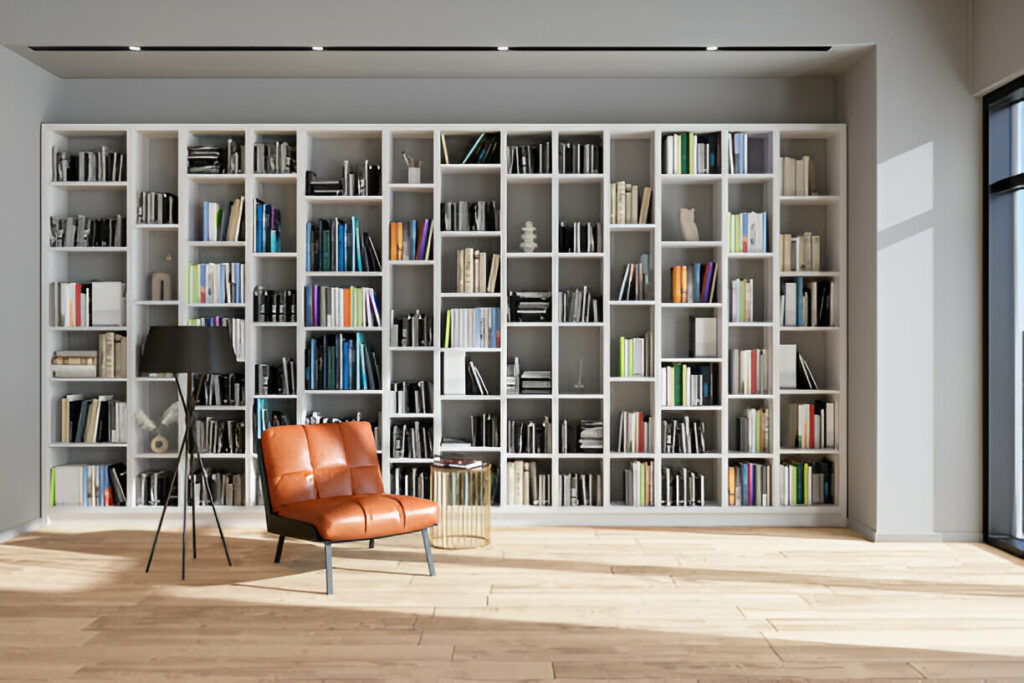Step 1: Assess Your Collection
Start by taking stock of your entire book collection. This will help you understand the scale of the task and identify any duplicates or books that no longer serve a purpose.
- Inventory Your Books: Consider listing or tagging each book to keep track of your collection.
- Evaluate Condition: Decide which books are in good condition and worth keeping, and which ones might be better off donated or recycled.
Step 2: Decide on a System
Choosing an organizational method that suits your needs is crucial. Here are some popular systems:
- By Genre: Fiction, non-fiction, biographies, etc.
- By Author: Alphabetical order by author’s last name.
- By Color: Arrange books based on their spine color for a visually striking display.
- By Size: Group books by height or width to create uniform rows.
- By Frequency of Use: Place frequently read books in easily accessible spots.
- By Topic or Theme: Organize books around specific subjects or interests.
Select a system that makes the most sense for how you interact with your books.
Step 3: Create Categories
Based on your chosen system, group similar books together.
- Use Bins or Baskets: For categorizing smaller items or books that don’t have a permanent place.
- Labels: Implement labels for each category to maintain organization.
Step 4: Implement a Shelf-Management Plan
Once your books are grouped, arrange them on the shelves in a way that makes sense and is visually appealing.
- Bookends: Use bookends to keep books upright and prevent them from leaning.
- Dividers: Incorporate dividers between categories for a neat look.
- Shelf Liners: Add shelf liners to protect your books and make dusting easier.
Step 5: Consider Storage Solutions
Maximize your storage space with creative solutions.
- Vertical Space: Utilize the full height of your bookshelves by stacking books neatly.
- Floating Shelves: Install floating shelves to add more display space without taking up floor space.
- Custom Bookcases: Consider building custom bookcases tailored to your specific needs and the layout of your room.
- Stackable Storage: Use stackable storage bins for lesser-used books or memorabilia.
Step 6: Regular Maintenance
To keep your bookshelf organized over time, establish a routine for maintaining order.
- Regular Tidying: Set aside time periodically to straighten up and reorganize as needed.
- One In, One Out Rule: For every new book you add, consider removing one that you no longer need.
- Seasonal Rotations: Rotate books seasonally to keep your displays fresh and interesting.
Organizing Different Types of Books
Fiction Books
- By Series: Group books from the same series together, arranged in reading order.
- By Author: Alphabetize by the author’s last name for easy access.
- By Genre: Categorize into subgenres like mystery, science fiction, romance, etc.
Non-Fiction Books
- By Subject: Organize based on topics such as history, science, self-help, etc.
- Alphabetically: Arrange by the author’s last name or book title.
- By Topic Relevance: Group related subjects together for quick reference.
Children’s Books
- By Age Group: Organize based on the intended age of the reader.
- By Author or Series: Keep popular authors or series together for easy access.
- By Topic: Group books by themes like animals, bedtime stories, educational topics, etc.
Reference Materials
- By Category: Organize dictionaries, encyclopedias, and other reference books separately.
- By Subject: Group reference books based on subject matter for easy retrieval.
Eco-Friendly Book Organization
Adopting sustainable practices in organizing your bookshelf not only helps the environment but also aligns with a responsible lifestyle.
- Recycled Materials: Use shelving units and organizers made from recycled materials.
- Second-Hand Shelves: Consider purchasing used bookcases to reduce waste.
- Digital Copies: For duplicates or less frequently used books, consider digitizing them to save space and resources.
- Donate Unread Books: Share books you no longer need with friends, libraries, or charitable organizations.
- Repair Damaged Books: Instead of discarding damaged books, repair them using eco-friendly adhesives and materials.
Creative Display Ideas
Make your bookshelf not just functional but also a work of art with these creative display ideas.
- Color Coordination: Arrange books by the color of their spines for a visually appealing gradient effect.
- Angle Stacking: Stack books at angles to create depth and visual interest.
- Mix with Decor: Incorporate decorative items like vases, photographs, or small sculptures between books.
- Vertical Displays: Use bookends to create vertical stacks of books for a unique look.
- Themed Sections: Create sections dedicated to specific themes or moods, such as a “Beach Reads” corner or a “Mystery Night” display.
Real-Life Examples
See how others have organized their bookshelves:
- The Minimalist Approach: Some prefer a clean, minimal look with only a select few books on display, emphasizing quality over quantity.
- The Maximalist Style: Others enjoy a fuller, more eclectic display, mixing books of various colors and sizes for a vibrant look.
- The Functional Focus: Those who prioritize functionality might opt for alphabetized rows with clear labels for quick access.
Each approach has its merits, and the best method is the one that suits your personal preferences and needs.
Conclusion
Organizing your bookshelf is a rewarding endeavor that can transform your reading experience and enhance your living space. By assessing your collection, choosing an organizational system, and implementing sustainable practices, you can create a beautiful and functional bookshelf that you’ll enjoy for years to come. So roll up your sleeves, grab a cup of tea, and dive into the world of book organization—your future self will thank you.


